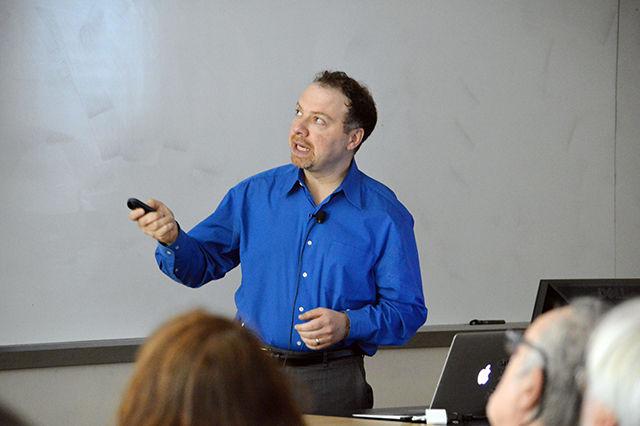Astrophysicist and Nobel Laureate Adam Riess says the universe is a lot like a loaf of raisin bread baking in the oven.
“The galaxies are kind of like the raisins, and as the loaf rises, the raisins, which are far apart to begin with, rush apart even faster,” Riess told a group of more than 100 people including physics students, faculty members and distinguished guests at the 2015 L.H. Thomas Lecture in Riddick Hall Monday afternoon. “It doesn’t matter where you are in this loaf; everything looks like it’s moving away from everything else.”
Riess, who is a researcher at the Space Telescope Science Institute in Baltimore, Maryland, and a professor at Johns Hopkins University was one of the recipients of the 2011 Nobel Prize in physics for the discovery that the universe is expanding at an accelerating rate. Before his and his colleagues’ discovery, many scientists had posited the rate at which the universe was expanding was decreasing.
Scientists have now established that the universe is expanding at a rate 20 percent faster than it was 5 billion years ago, Riess said. Edwin Hubble first demonstrated that the universe was expanding in 1929 by showing that galaxies outside the Milky Way, in which earth’s solar system resides, were moving away from each other.
Only about 5 percent of the universe is composed of planets, stars and gaseous structures, with the remaining 95 percent comprising dark matter and dark energy.
However, Riess conceded that dark matter and dark energy are still not completely understood.
To elucidate this point, during his talk, Riess showed a clip from the show “The Big Bang Theory” in which Sheldon, a theoretical physicist, derides the Nobel Prize acceptance ceremony in Stockholm, which is the same event at which Riess was honored for his research.
“Look at these men,” the character said. “They’ve managed to win the top science prize in the world with no more understanding of the quantum underpinnings of the expansion of the early universe than God gave a goose.”
Riess was awarded the Nobel Prize in conjunction with Brian Schmidt, who like Riess was a member of the High-Z Supernova Search Team, and Saul Perlmutter, head scientist of the Supernova Cosmology Project, a competitor to Riess’ team which published a paper in 1999 corroborating the results of Riess’ 1998 paper.
In addition to the Nobel Prize, in 2008, Riess was awarded a MacArthur “Genius” Grant, and he, Schmidt and Perlmutter were awarded the 2015 Breakthrough Prize in fundamental physics.
Stephen Reynolds, an NC State professor of physics, said it is important the L.H. Thomas Lecture series brings notable scientists in their fields to the university.
“It is really inspiring to students that they get the opportunity to speak with these scientists not just about science, but also about the lives and careers that they’ve chosen to lead,” Reynolds said.
Reynolds said Riess spent part of his day lecturing in Reynolds’ first-year physics class on mechanics and also had lunch with graduate students and undergraduate students.
The L.H. Thomas Lecture series began in 1980 and is named for the late Llewellyn Hilleth Thomas, a physics professor who taught at NC State from 1968 until his death in 1992.
Past speakers who have participated in the lecture series include other Nobel Laureates such as John Mather, Ahmed H. Zewali and Linus Pauling, who is the only person to have won two Nobel Prizes unshared with anyone. Pauling was awarded the 1954 Nobel Prize in chemistry as well as the 1962 Nobel Peace Prize for his “for his campaign against nuclear weapons testing.”








